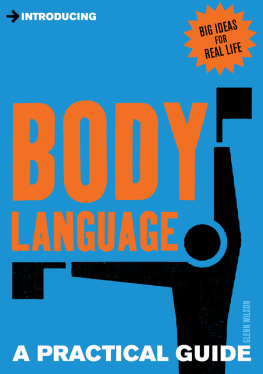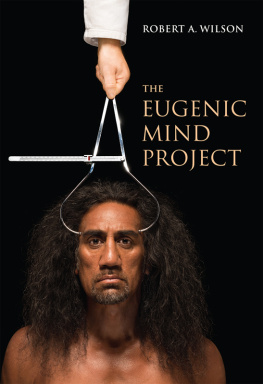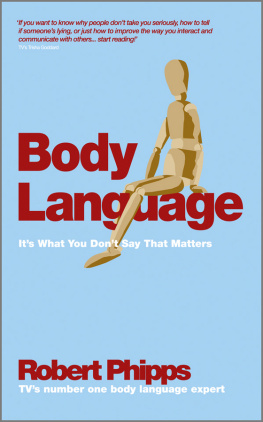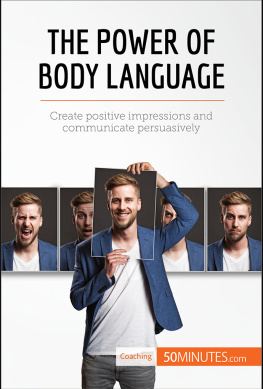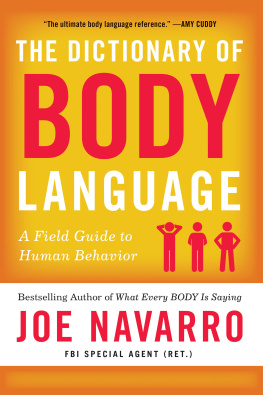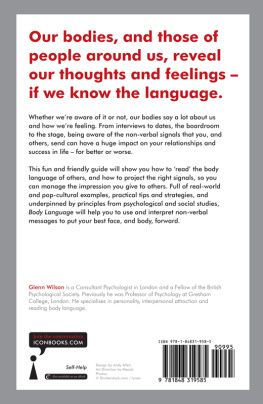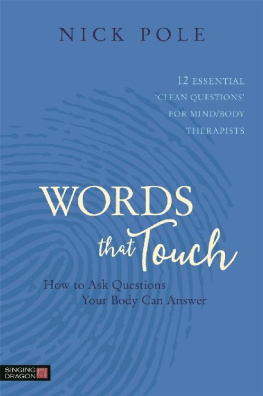Wilson - Introducing Body Language : a Practical Guide
Here you can read online Wilson - Introducing Body Language : a Practical Guide full text of the book (entire story) in english for free. Download pdf and epub, get meaning, cover and reviews about this ebook. City: Duxford, year: 2012, publisher: Icon Books, genre: Romance novel. Description of the work, (preface) as well as reviews are available. Best literature library LitArk.com created for fans of good reading and offers a wide selection of genres:
Romance novel
Science fiction
Adventure
Detective
Science
History
Home and family
Prose
Art
Politics
Computer
Non-fiction
Religion
Business
Children
Humor
Choose a favorite category and find really read worthwhile books. Enjoy immersion in the world of imagination, feel the emotions of the characters or learn something new for yourself, make an fascinating discovery.
- Book:Introducing Body Language : a Practical Guide
- Author:
- Publisher:Icon Books
- Genre:
- Year:2012
- City:Duxford
- Rating:3 / 5
- Favourites:Add to favourites
- Your mark:
- 60
- 1
- 2
- 3
- 4
- 5
Introducing Body Language : a Practical Guide: summary, description and annotation
We offer to read an annotation, description, summary or preface (depends on what the author of the book "Introducing Body Language : a Practical Guide" wrote himself). If you haven't found the necessary information about the book — write in the comments, we will try to find it.
Abstract: A Practical Guide to using and understanding body language to get ahead
Introducing Body Language : a Practical Guide — read online for free the complete book (whole text) full work
Below is the text of the book, divided by pages. System saving the place of the last page read, allows you to conveniently read the book "Introducing Body Language : a Practical Guide" online for free, without having to search again every time where you left off. Put a bookmark, and you can go to the page where you finished reading at any time.
Font size:
Interval:
Bookmark:
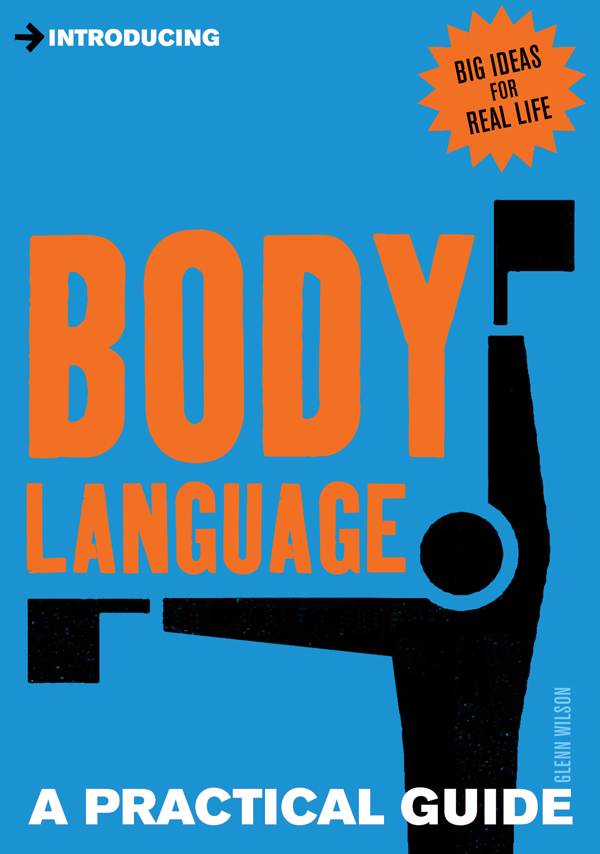
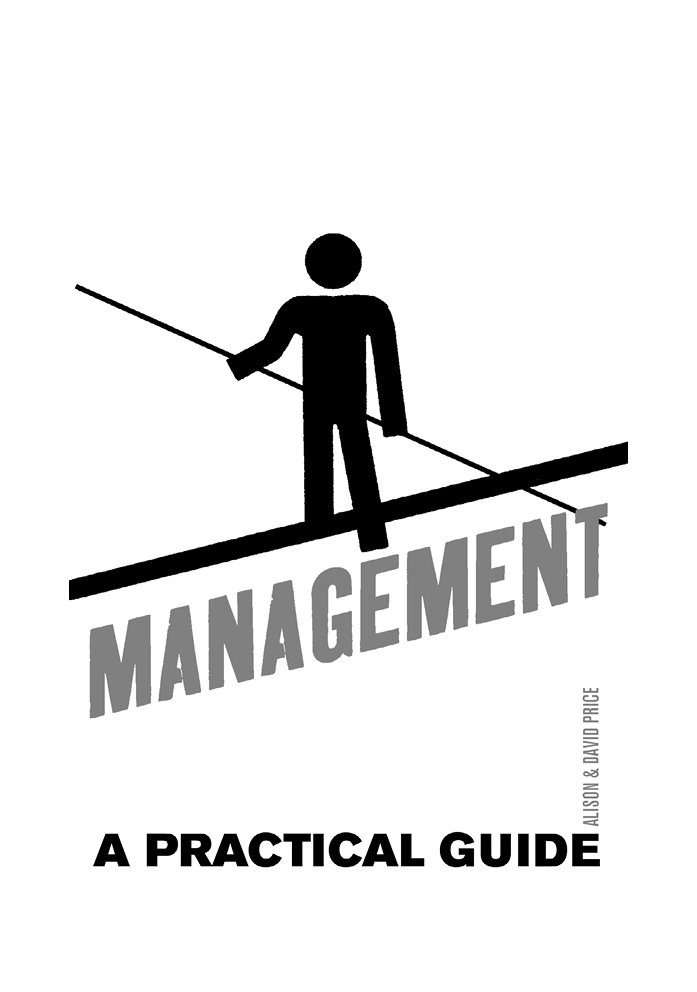
First published in the UK in 2012
by Icon Books Ltd,
Omnibus Business Centre
3941 North Road
London N7 9DP
email:
www.iconbooks.net
This electronic edition published in the UK in 2012 by Icon Books Ltd
ISBN: 978-184831-437-5 (ePub format)
ISBN: 978-184831-490-0 (Adobe eBook format)
Text copyright 2012 Glenn Wilson
The author has asserted his moral rights.
No part of this book may be reproduced in any form, or by any means, without prior permission in writing from the publisher.
Typeset in Avenir by Marie Doherty
Dr Glenn Wilson is Visiting Professor of Psychology at Gresham College, London and a Fellow of the British Psychological Society. He specialises in personality, interpersonal attraction and reading body language.
Importance of body language. How it reinforces and contradicts spoken language and betrays feelings we might prefer to cover up. Origins of mind reading ability and its deficits. Cross-cultural uniformities and differences. The many applications of reading body language.
Importance of early impressions and self-presentation. How various modes of dress and the kind of car we drive come across to other people. The impact of different hair styles, facial hair, tattoos, piercings, wearing glasses and make-up. How to impress at a job interview.
How we use our eyes and facial muscles to convey our feelings and intentions. What we can read in the facial expressions of others. The various types of smiles and what they mean. Two sides to the face. Flushing and blushing. The importance of gaze.
How to tell whether other people are on-side or interested in us. Are they warm or cold, attracted or repulsed? Reading the signals of courtship and intimacy. Recognising when someone is bored with us. How to make someone warm towards us.
How can we tell if someone is sincere or being deceitful? Some famous liars and how they might have been spotted. How to conceal our own dishonesty and to come across as trustworthy. New technologies for lie detection.
When do we feel crowded? Etiquette concerning the use of space. Jostling for territory. The sun lounger syndrome. Body orientation and seating arrangements. How space can be manipulated to make us seem powerful or to put others at their ease.
How the power game is played out in the ordinary world and among politicians. The signals of dominance and submission. Handshakes and their meaning. Bodily stance. Strategies for getting what we want.
The evolutionary basis of beauty and sex appeal. Signals of masculinity/femininity. Innate releasers and imprinting of sex targets. How to tell if someone is unattached and attracted to us. Body language at parties. Techniques of flirting. Proteans and pseudo-flirting. The meaning of kisses. Tone of voice. Tips for impressing women and seducing men.
What is stress and what are the signs? How do we know when someone is under pressure and about to crack emotionally? How do we detect rising stress in ourselves? What can we do to relax and take control when we detect that our own stress levels are rising out of control? Stressed relationships.
Body language on the stage. How actors convey feelings through the use of posture and gesture. Do they need to experience these feelings themselves or can they be generated in an audience through technique alone? Can charisma be acquired? How to make a good speech.
Fie,fie upon her!
Theres language in her eye, her cheek, her lip.
Nay, her foot speaks: her wanton spirits look out
At every joint and motive of her body.
Ulysses, in Shakespeares Troilus and Cressida
I speak two languages Body and English.
Mae West
There are many jokes about dogs that talk. They are funny because we know that dogs dont talk. Or do they? Dog owners know that Fido can express himself quite effectively in a variety of ways. He can wag his tail and bark excitedly when anticipating food or walkies. He can lower his head and cower as though expecting to be hit when feeling guilty about stealing some sausages. These emotions are readily understood by dog owners. Fido can also glean a great deal about how we are disposed towards him from our gestures and behaviour. Although he might be responsive to the shape of certain words, such as his own name, most of this communication is through the reading of body language and tone of voice.
Humans dont have to rely on such indirect signals because we have an advanced language capability and can state our case much more clearly and explicitly. At least we think we can.
 All of the emotional signalling that animals use is still present in humans and registers importantly with us. After all, we cannot always trust what someone tells us: they may have reasons for wanting to be deceptive. Some things, like cold facts and statistics, are best communicated by words and numbers but attitudes and intentions are better read through body language.
All of the emotional signalling that animals use is still present in humans and registers importantly with us. After all, we cannot always trust what someone tells us: they may have reasons for wanting to be deceptive. Some things, like cold facts and statistics, are best communicated by words and numbers but attitudes and intentions are better read through body language.
In some ways, body language is even more highly developed in humans because we have a most expressive face that has developed in connection with our preferred front-on interaction. Powerful signals are transmitted by facial expressions. We also have a highly developed capacity for mind-reading. This is the very useful capacity to second-guess what somebody has in mind for us based on voice inflexions and body language cues. Obviously it is important to know whether or not someone fancies us or wishes we would just go away. It is important to know whether they are on-side or on the verge of attack. Mind-reading ability has been retained and in some ways further evolved in humans because it has considerable survival value.
Where there is a discrepancy between what is said verbally and the feelings that are indirectly transmitted through facial expression and body language, we quite rightly set greater store by what we see, rather than what we are being told. This is because body language leaks certain emotions and attitudes that we might have preferred to conceal from those who observe us (and they know it). The reception process is immediate and largely unconscious, though it can be made conscious through a process of analysis such as that used in this book.
It is widely said that 93% of our communication is through body language, while only 7% is based in the words themselves. Although Albert Mehrabian, the researcher on whose work in the 1960s this assertion is based, has said this is a simplification of his findings, others have produced data suggesting that around 6070% of our communication is non-verbal.
 Studies of US presidential election campaigns have been done in which the speeches of candidates are assessed through watching videos with and without sound, listening to sound recordings alone and simply reading transcripts. This allows comparison of the power of the various channels to influence voter choices and it confirms that visual body language, and even tone of voice, are much more persuasive than the verbal content of the message. Not surprisingly a new breed of spin doctors, image consultants and television coaches has grown in strength.
Studies of US presidential election campaigns have been done in which the speeches of candidates are assessed through watching videos with and without sound, listening to sound recordings alone and simply reading transcripts. This allows comparison of the power of the various channels to influence voter choices and it confirms that visual body language, and even tone of voice, are much more persuasive than the verbal content of the message. Not surprisingly a new breed of spin doctors, image consultants and television coaches has grown in strength.
Font size:
Interval:
Bookmark:
Similar books «Introducing Body Language : a Practical Guide»
Look at similar books to Introducing Body Language : a Practical Guide. We have selected literature similar in name and meaning in the hope of providing readers with more options to find new, interesting, not yet read works.
Discussion, reviews of the book Introducing Body Language : a Practical Guide and just readers' own opinions. Leave your comments, write what you think about the work, its meaning or the main characters. Specify what exactly you liked and what you didn't like, and why you think so.

